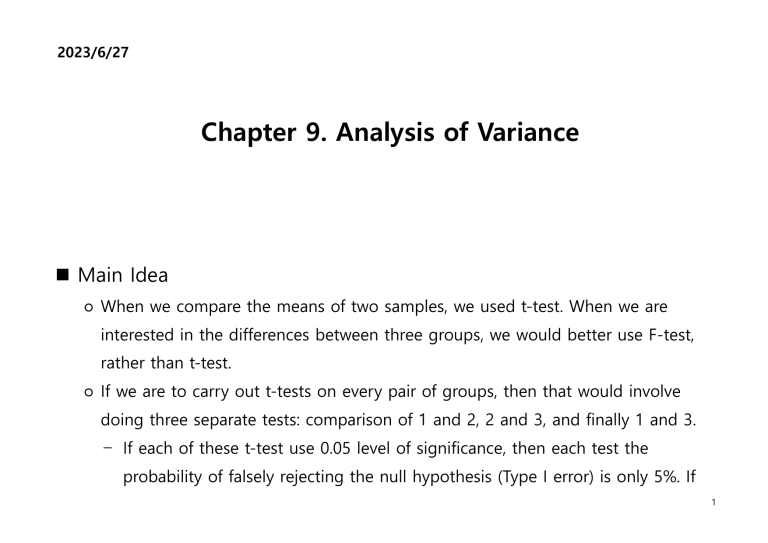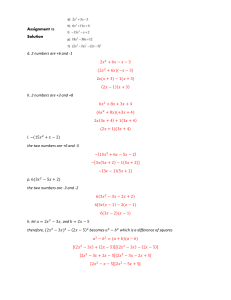
2023/6/27 Chapter 9. Analysis of Variance Main Idea ○ When we compare the means of two samples, we used t-test. When we are interested in the differences between three groups, we would better use F-test, rather than t-test. ○ If we are to carry out t-tests on every pair of groups, then that would involve doing three separate tests: comparison of 1 and 2, 2 and 3, and finally 1 and 3. – If each of these t-test use 0.05 level of significance, then each test the probability of falsely rejecting the null hypothesis (Type I error) is only 5%. If 1 we assume each test is independent, then the overall probability of no Type I error is .953 = .857. – So, the probability of at least one Type I error is 1 - .857 = .143 or 14.3%. ○ An ANOVA produces an F-statistic, which is similar to the t-statistic in that it compares the amount of systematic variance to the unsystematic variance. – It tests overall effect 𝑥̅1 = 𝑥̅2 = 𝑥̅3 . Treatment Sample size Sample mean 1 2 j x11 x12 x21 . . . x22 . . . x2j . . . x2k . . . xn11 xn22 xnjj xnkk n1 𝑥̅1 n2 𝑥̅2 nj 𝑥̅𝑗 nk 𝑥̅𝑘 ... x1j k ... x1k ­ Xij= ith observation of jth sample. 2 ­ nj = the number of observations in the same j. ­ 𝑥̅𝑗 = the mean of the jth sample. ­ 𝑥̿ = the gran mean of all the observation. ○ Test statistic ­ Sum of Squares for Model (between-treatment variation) 𝑘 SSM = ∑ 𝑛𝑗 (𝑥̅𝑗 − 𝑥̿ )2 𝑗=1 If 𝑥̅1 = 𝑥̅2 = . . . = 𝑥̅𝑘 , then SSM=0. ­ Sum of Squares of Error (within-treatments variation) 𝑘 𝑛𝑗 SSE = ∑ ∑ 𝑛𝑗 (𝑥𝑖𝑗 − 𝑥̅𝑗 )2 𝑗=1 𝑖=1 ­ Mean Squares of Model MSM = ­ Mean Squares of Error 𝑆𝑆𝑀 𝑘−1 3 MSE = 𝑆𝑆𝐸 𝑛−𝑘 F= 𝑀𝑆𝑀 𝑀𝑆𝐸 - Test statistic Two types of datafile. ­ Wide type file `Bumper 1` `Bumper 2` `Bumper 3` `Bumper 4` 1 610 404 599 272 2 354 663 426 405 3 234 521 429 197 4 399 518 621 363 5 278 499 426 297 6 358 374 414 538 7 379 562 332 181 8 548 505 460 318 9 196 375 494 412 10 444 438 637 499 ­ Long type datafile values ind 4 1 610 Bumper 1 2 354 Bumper 1 3 234 Bumper 1 4 399 Bumper 1 5 278 Bumper 1 6 358 Bumper 1 ○ R only uses long type datafile for AOV or Regression, and etc. You have to use command “stack” and “unstack” to change the datafile types. Ex 9-1) A car company is considering several new types of bumpers. To test how well they react to low-speed collisions, 10bumpers of each of four different types were installed. The cost of repairing the damage in each case was assessed. Is there sufficient evidence at the 5% significance level to infer that the bumpers differ in their reactions to collision? > > > > library(readxl) bumper <- read_excel("R/data/22F data/Ex9-1.xlsx") View(Ex9_1) bumperstack <-stack (Ex9-1) # Change into a long file. 5 > summary(aov(values~ind)) Df Sum Sq Mean Sq F value Pr(>F) ind 3 150884 50295 4.056 0.0139 * Residuals 36 446368 12399 --Signif. codes: 0 ‘***’ 0.001 ‘**’ 0.01 ‘*’ 0.05 ‘.’ 0.1 ‘ ’ 1 The p-value of bumper is .014 << .05. We can conclude that there exist differences in the cost between bumpers. Ex 9-2) Two-factor Experiment A survey was conducted in which Americans aged between 37 and 45 were asked how many jobs they have held in their lifetimes. Education levels are 1: Less than high school 2: High school 3: Some college without degree 4: At least one university degree. The gender categories are: 1: male and 2: female. 6 Can we infer that differences exist between genders and educational levels? > X14_4b <- read_excel("R/data/22F data/Ex9-2.xlsx") > View(Ex9_2) > twoaov <- aov(Jobs ~ Gender*Education, data= Ex9_2) > anova (twoaov) Analysis of Variance Table Response: Jobs Df Sum Sq Mean Sq F value Pr(>F) Gender 1 11.25 11.250 1.1655 0.2837386 Education 1 134.56 134.560 13.9406 0.0003624 *** Gender:Education 1 0.16 0.160 0.0166 0.8978966 Residuals 76 733.58 9.652 --Signif. codes: 0 ‘***’ 0.001 ‘**’ 0.01 ‘*’ 0.05 ‘.’ 0.1 ‘ ’ 1 The p-value for Gender is .29 >> .05. There is no evidence at the 5% significance level to infer that differences in the number of jobs exist between men and women. The p-value for Education is .00036 << .05. There is sufficient evidence to conclude that differences in the number of jobs exist between educational level. 7 > twoaov1 <- aov(Jobs ~ Gender + Education, data= Ex9_2) > anova (twoaov1) Analysis of Variance Table Response: Jobs Df Sum Sq Mean Sq F value Gender 1 11.25 11.250 Pr(>F) 1.1806 0.2806246 Education 1 134.56 134.560 14.1210 0.0003316 *** Residuals 77 733.74 9.529 --Signif. codes: 0 ‘***’ 0.001 ‘**’ 0.01 ‘*’ 0.05 ‘.’ 0.1 ‘ ’ 1 8





